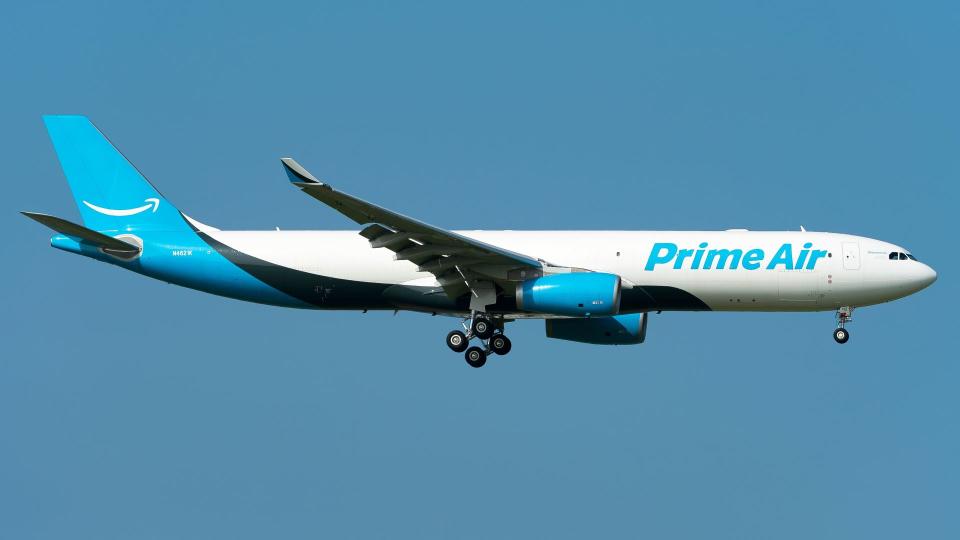Hawaiian Airlines’ welcomes new Amazon revenue stream

The smooth debut of Hawaiian Airlines’ first freighter aircraft this month and the cash it, and sister aircraft, will generate from Amazon is a shot in the arm for an airline with losses that widened to $48.7 million in the third quarter from $9.3 million a year ago.
Hawaiian Airlines (NASDAQ: HA) began flying the Airbus A330-300 converted freighter on Oct. 2 from the e-commerce giant’s air logistics superhub at Cincinnati-Northern Kentucky International Airport to the new West Coast hub in San Bernardino, California. Amazon (NASDAQ: AMZN) plans to lease nine more of the widebody freighters — former passenger planes that are being overhauled to carry cargo containers — and turn them over to Hawaiian to operate on its behalf.
“It’s great to get into a place where, instead of just incurring startup costs and no revenue, we’re operating revenue flights and getting the business growing. Our on-time performance has been very good so far, which is crucial in this arrangement,” CEO Peter Ingram said in an analyst briefing following the company’s earnings release last Tuesday.
Launch costs for the A330 cargo jets include hiring new pilots and mechanics and training them.
Hawaiian is carrying about 25% more pilots than it did in 2019 for the same amount of capacity because of preparations to bring into service the A330s and a dozen Boeing 787 Dreamliners, the first of which is expected to begin passenger operations early next year.
“As the capacity that we’re planning for comes online, our training bubble will deflate and pilot productivity will improve. We expect this improvement to grow throughout 2024 and decrease” unit costs by 50%, said CFO Shannon Okinaka.
Management said the marginal revenue produced by a single freighter during the fourth quarter isn’t material to earnings, but as the fleet grows the income statement in 2025 will include line items for the Amazon Air transportation work.
Amazon is scheduled to add nine more A330-300 passenger-to-freighter aircraft in 2024 and the final one in 2025. Hawaiian pursued a relationship with Amazon to diversify its business.
Meanwhile, Hawaiian signed a seven-year contract with Lufthansa Technik for component maintenance, logistics support and establishing parts stockpiles for its Airbus A330 and A321 fleets at the airline’s main maintenance bases, including Los Angeles International Airport. The parts pooling arrangement covers the A330 freighters, as well as 24 A330s operated in passenger configuration.
Hawaiian Airlines has been buffeted by a series of external circumstances that have slowed its recovery from the COVID crisis. Lost traffic due to the wildfires on Maui and a growing number of Airbus A321 aircraft sidelined by an engine manufacturing flaw are the latest setbacks. The company said the wildfires caused $25 million in lost revenue.
In August, engine manufacturer Pratt & Whitney discovered defects with powder metal used to make geared turbofan engines and said hundreds of engines will need to be removed from aircraft for inspection over the next four years. The engine disclosure resulted in late flight cancellations.
Hawaiian executives said they have two aircraft grounded now for engine issues and expect to have up to four out of service at any given time over the next few months. Going forward, the company will be better able to plan for missing aircraft and avoid cancellations. Pratt & Whitney will compensate Hawaiian for its failure to provide engine spares in recent months, but the agreement expires later this quarter.
Before that, Hawaiian had to cope with a handful of A321 narrowbody jets being out of service while Pratt & Whitney waited for parts to do engine maintenance; Boeing production snafus that delayed delivery of 787s ordered by Hawaiian; slow normalization of travel with Japan, a major market for Hawaiian Airlines, because the country was late to lift pandemic travel and health restrictions last year; Hawaii’s decision to virtually shut down travel for a long period; and delays and added costs associated with construction last year on the primary runway at Honolulu Airport, the airline’s main hub.
Hawaiian’s revenue per available seat mile fell 11.5% in the third quarter, with one point of deterioration attributed to reduced belly cargo because of the air cargo market’s cooldown from pandemic peaks.
More FreightWaves/American Shipper stories by Eric Kulisch.
Subscribe to the American Shipper Air newsletter.
RELATED NEWS:
Amazon’s largest cargo jet makes debut
Orders for freighter aircraft slow ‘to a trickle’
The post Hawaiian Airlines’ welcomes new Amazon revenue stream appeared first on FreightWaves.
